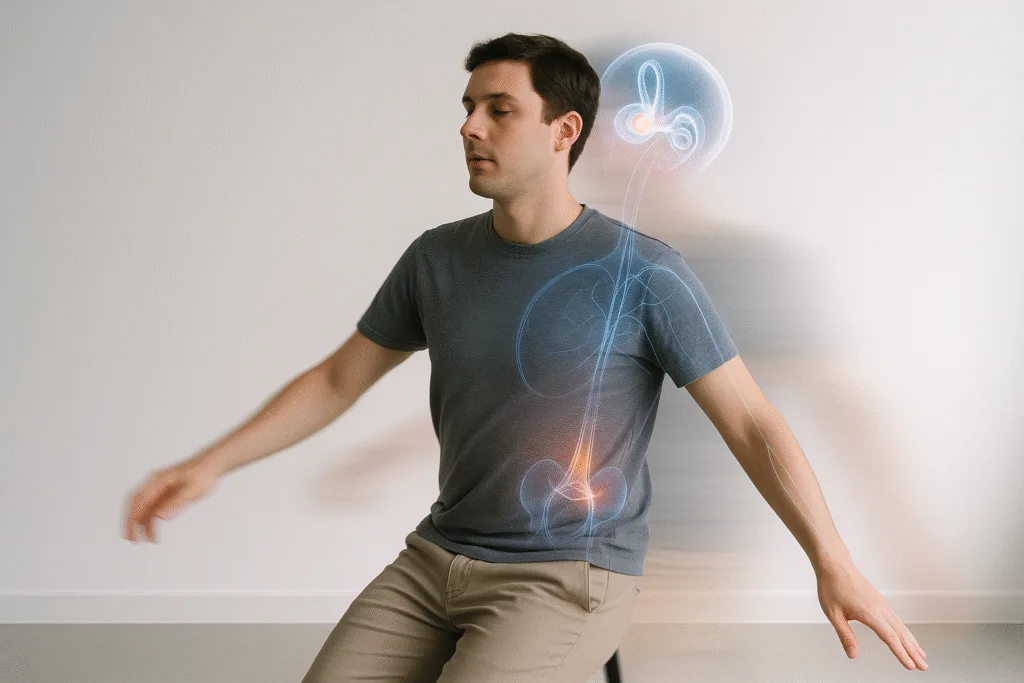The quick spin orientation test reveals how your brain manages one of its fastest and most complex tasks: regaining control after sudden movement. A brief spin is harmless, but inside your inner ear, your balance system enters a controlled state of chaos. Fluid moves, sensors fire at maximum intensity, and your brain struggles to match what your eyes see with what your body feels.
This test shows what happens when your visual system, vestibular system and proprioception fall out of sync — and how quickly the brain recovers.
Even though modern life rarely challenges these senses, your body still carries the same equipment early humans used to navigate unstable terrain, escape predators and maintain orientation in rapid motion.
O experimento abaixo reativa essa inteligência corporal esquecida.
Step 1 — Stand in an Open Space With Good Footing
Choose a spot with room to spin safely.
Feet slightly apart.
Body relaxed.
Your balance system begins evaluating the environment before anything happens. This “pre-check” is instinctive — your nervous system verifies that you’re safe to lose orientation briefly.
Step 2 — Focus Your Eyes on a Single Point in Front of You
Pick a doorknob, a corner of the room, or any fixed object.
Fixing your gaze prepares your visual system for the sudden disruption. This anchor will become important later, when your brain tries to restore orientation.
Step 3 — Perform One Gentle Spin to the Right
Turn your body once, at a steady pace, without rushing.
As you rotate, the fluid in your inner ear canals moves. These canals are designed to detect rotation and acceleration. The moment they sense motion, they fire signals at full speed.
This is the beginning of the quick spin orientation test.
Step 4 — Stop and Keep Your Eyes on the Same Point
Once you finish the rotation, remain still and keep staring at the object you chose earlier.
What happens now is an internal mismatch:
Your eyes tell your brain that you stopped, but the inner ear fluid is still moving. This conflict creates the sensation of spinning — even though your body is still.
It’s a safe, temporary disconnection between two sensory systems.

Step 5 — Take a Breath and Let the Sensation Play Out
Do not fight the sensation.
Let your body feel what it feels.
As the inner ear fluid stabilizes, the spinning illusion fades. This is your brain recalibrating orientation — an ancient survival process that kept early humans upright after sudden movement, falls, or rapid turns.
Step 6 — Try the Same Spin in the Opposite Direction
Agora gire para a esquerda, no mesmo ritmo.
Different directions activate different canals and different reflex pathways. Some people feel a stronger effect in one direction. This asymmetry is normal and often reveals which side of the body is more dominant in balance control.
Step 7 — Walk Three Slow Steps Forward
After the second spin, walk slowly.
Your proprioception — the sense of body position — now has to work harder.
The quick spin orientation test exposes how walking depends on at least three systems working together:
- vision
- inner ear balance
- muscle/joint feedback
When one is temporarily disturbed, the others compensate.
Step 8 — Close Your Eyes and Stand Still for Five Seconds
Now remove visual input completely.
Stand tall, hands by your sides.
Without your eyes, your brain must rely entirely on your vestibular system and muscle sensors. The sensation of instability may return slightly — this is because the inner ear takes longer to reset than your vision.
This step strengthens your internal orientation awareness.
Step 9 — Blink Several Times and Focus Again on the Original Object
Open your eyes and blink until your vision feels stable.
Blinking helps “refresh” the visual processing system and forces your brain to synchronize signals from the eyes with signals from the inner ear.
This syncing process is exactly what early humans relied on for quick movement recovery.
Step 10 — Observe the Final Stability Reset
Within seconds, everything aligns again:
Your vision stabilizes.
Your balance centers calm down.
Your sense of direction returns.
Your steps become natural.
The quick spin orientation test reveals how resilient and adaptable your orientation system is — even under sudden stress. This rapid recovery reflects an ancient mechanism designed to keep humans balanced during running, climbing, dodging obstacles or navigating unpredictable environments.
What This Experiment Teaches About Your Body
The test highlights five essential principles about your sensory system:
1. Your inner ear reacts faster than your eyes
Rotation begins affecting balance before your eyes even notice movement.
2. Sensory conflict is normal
Feeling “off” after spinning simply means the brain is interpreting mixed data.
3. Orientation is layered
Vision, inner ear and proprioception constantly negotiate control.
4. Your recovery system is ancient
The reset process evolved long before modern environments simplified human movement.
5. You can train your balance
Repeating controlled challenges strengthens your sensory coordination.
O corpo humano é muito mais adaptável do que parece — você só precisa colocá-lo em condições que revelem isso.
Next Safe Extreme You Should Try
If the quick spin orientation test showed how your brain regains control after sudden movement, the next experiment reveals how your lungs and circulation respond to controlled oxygen restriction.
Recommended next article:
“The Short Breath Focus Test — How Oxygen Levels Shape Your Attention”
